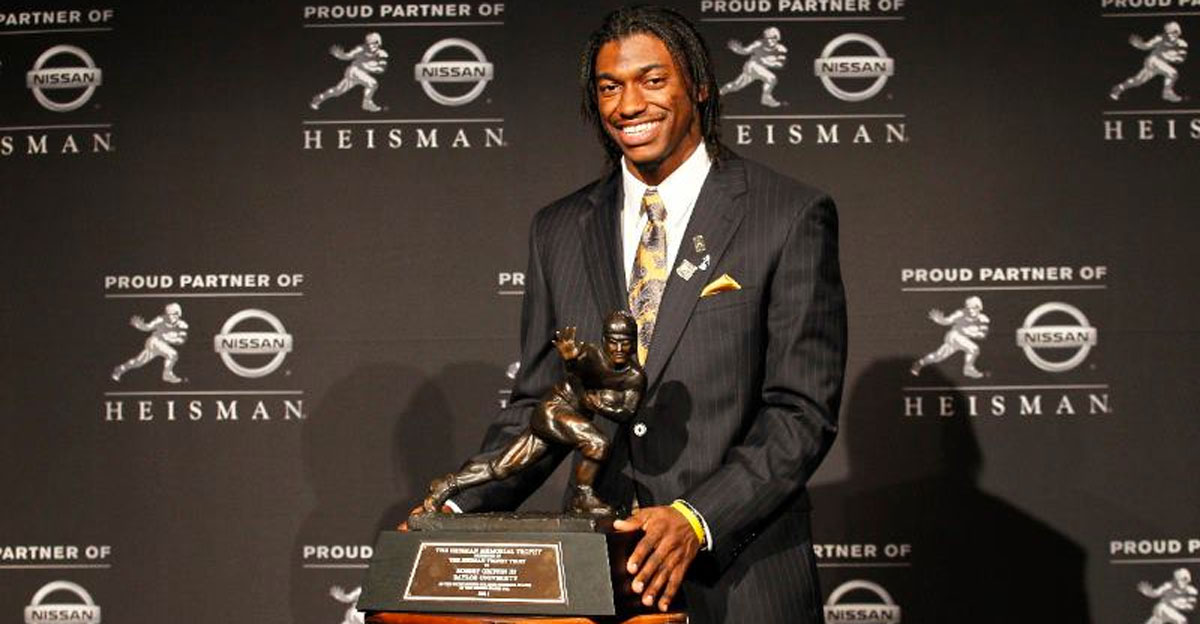In the rich history of college football, the Heisman Trophy is the gem—a beacon of personal excellence and a season for the ages. The majority of winners come from college football’s blue-blooded tradition. But the Baylor Bears stunned the country in 2011 when their turbo-legged, rocket-armed quarterback claimed the Heisman and put Waco on the map as a football town.
That winner: Robert Griffin III, or as he came to be widely known, RG3. His win wasn’t simply a personal achievement—it redirected the course of Baylor football history and provided the program with a legacy moment that continues to resound today.

Robert Griffin III: The Lone Bear King of the Heisman
Let’s be clear: Baylor has one Heisman winner, but if your sole winner is Robert Griffin III, then that’s good enough to warrant a banner.
RG3 was a sensation in 2011. He wasn’t merely quick—he was lightning. He didn’t merely throw deep bombs—he threw missiles. The sophomore quarterback passed for 4,293 yards, accumulated 37 touchdown passes, contributed 699 rushing yards and 10 touchdowns on the ground, and ended with a jaw-dropping 189.5 passer rating—best in the country.
Key Game: In a wild contest vs. No. 5 Oklahoma, Griffin threw a game-winning 34-yard touchdown pass with 8 seconds remaining to propel Baylor to a historic 45–38 victory—their first ever over the Sooners. That instant all but guaranteed his Heisman destiny.
Heisman Voting:
- 1st Place Votes: 405
- Total Points: 1,687
- Margin of Victory: 280 points over second-place Andrew Luck
When he received the award, RG3 gave the now-famous line:
“The hotter the heat, the harder the steel. No pressure, no diamonds. We compete. We win. We are Baylor.”
Griffin didn’t merely win a trophy—he rebranded Baylor football overnight. Recruits noticed. Fans mobilized. And Waco became a legitimate football destination. Robert Griffin III deserved every pound of his Heisman, but the 2011 class was loaded. Let’s go through the top-shelf competition RG3 beat out:
Andrew Luck (Stanford)
Luck was going to win it. The Stanford star had passed for 3,517 yards and 37 touchdowns and was a cinch No. 1 draft choice (spoiler: he was). Composed in pressure situations and surgically accurate, he led Stanford to an 11-2 finish but couldn’t pilfer the flash from Griffin’s cape.
Trent Richardson (Alabama)
A bruising, bulldozing force of nature, Trent Richardson carried for 1,679 yards and 21 touchdowns. He helped Alabama win a BCS national championship and was awarded the Doak Walker Award. But Heisman voters liked flash, and RG3 supplied that in abundance.
Montee Ball (Wisconsin)
Ball had a video-game year: 1,923 rushing yards and 39 total scores, tying Barry Sanders’ all-time record. He led Wisconsin to the Big Ten championship and a Rose Bowl ticket.
Tyrann Mathieu (LSU)
Known as the “Honey Badger,” Tyrann Mathieu wasn’t a defensive back—he was a highlight reel. With 76 tackles, two interceptions, six forced fumbles, and two punt return touchdowns, he guided LSU to a flawless regular season. He was electric to watch, but the Heisman tends not to be awarded to defensive players.
Matt Barkley (USC)
Hampered by NCAA sanctions, Matt Barkley still played well with 3,528 yards and 39 touchdowns. His six-touchdown flourish against UCLA sealed a strong season, but he didn’t finish in the Top 5.
Case Keenum (Houston)
Talk about an air raid—Case Keenum passed for a dizzying 5,631 yards and 48 touchdowns. He shattered NCAA career records for touchdowns and yards and took Houston to a 13–1 campaign. Nevertheless, his non-Power Five affiliation negatively affected his national ranking.
Kellen Moore (Boise State)
Kellen Moore was the FBS’s winningest quarterback at the time, throwing for 3,800 yards and 43 touchdowns. Boise State went 12–1, but a missed field goal against TCU prevented them from party-crashing the BCS.
Russell Wilson (Wisconsin)
Yes, that Russell Wilson. Wilson, in his sole season as a Badger, passed for 3,175 yards and 33 touchdowns and had six more rushing touchdowns. He was cool, calm, and deadly—but Griffin’s jaw-dropping plays dictated the day.
LaMichael James (Oregon)
LaMichael James missed two games and still rushed for 1,805 yards and 18 touchdowns. His 7.3 yards per carry was the highest in the country. He led Oregon to a Pac-12 championship and Rose Bowl victory, but didn’t enjoy the national hype RG3 created.
What RG3’s Heisman Meant for Baylor
Griffin’s Heisman victory was an earthquake for Baylor. Prior to 2011, the Bears were a secondary thought in the Big 12. But RG3 turned things around—he demonstrated Baylor could hold its own nationally.
KEEP READING: Oklahoma State Cowboys Heisman Trophy Winners: A Complete List and History
In reality, his triumph opened the gates for a golden age for Waco. Only one year later, Baylor was ranked first in the country in total offense. During 2013 and 2014, they captured consecutive Big 12 championships.
Head coach Art Briles once declared, “Robert brought a new identity. He gave us confidence. He made Baylor football believe again.”
Today, his fingerprints are still on the program’s culture.
College Sports Network has you covered with the latest news, analysis, insights, and trending stories in football, men’s basketball, women’s basketball, and baseball!

